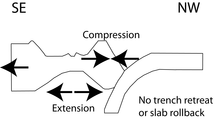Bransfield Basin
| Bransfield Basin | |
|---|---|
 This map of Antarctica and the bottom portion of South America shows the locations of Bransfield Strait, Drake Passage, and Scotia Arc. | |
| Type | Back-arc basin |
| Location | |
| Region | Northwest of the Antarctic Peninsula |
| Type section | |
| Country | Antarctica |
The Bransfield Basin is a Back-arc rift basin located off the Northern tip of the Antarctic Peninsula. The basin lies within a Northeast and Southwest trending strait that separates the peninsula from the nearby South Shetland Islands to the Northwest.[García 1]The basin extends for more than 500 kilometers from Smith Island to a portion of the Hero Fracture Zone.[1] The basin can be subdivided into three basins: Western, Central, and Eastern.[2] The Western basin is 130 kilometers long by 70 kilometers wide with a depth of 1.3 kilometers, the Central basin is 230 kilometers long by 60 kilometers wide with a depth of 1.9 kilometers, and the Eastern basin is 150 kilometers long by 40 kilometers wide with a depth of over 2.7 kilometers.[2]
Tectonic Development

The Bransfield Basin is considered to be a back-arc basin that is located behind the South Shetland Islands. The Islands are believed to have formed from a subduction event that occurred between the Phoenix Plate and the Antarctic plate roughly 200 million years ago during the Mesozoic.[3] [4][5] It is believed that the Pheonix plate stopped subducting under the Antarctic plate at least 4 million years ago during the Pliocene.[2][3][4][5]. Once the subduction event ceased, it is believed that the extension that created the basin was initiated. Aeromagnetic surveys have provided evidence that the extension occurred 1.8 Million years ago during the Pleistocene at a rate of 0.25 to 0.75 cenimeters per year. [5]
It is widely accepted that the Bransfield basin formed from extension caused by slab rollback.[2][3][4][5] New geophysical and structural data contradicts previously believed theories about slab rollback being the main mechanism for the opening of the basin.[García 1][1] A newer theory for the opening of the basin is attributed to sinistral strike-slip motion between the Scotia Plate and Antarctic plates.[1] It is theorized that the trench between the the Phoenix and Antarctic plates is locked in place and there is not any motion within the trench. The new data suggests trench retreat is not attributed as a mechanism for extension because there is a lack of seismic activity in the South Shetland Trench area, and that slab rollback is not a mechanism for extension too because if it were then Northwest-Southeast extension should be observed in the entire South Shetland region but instead compression can be observed.[1]
Geology

Natural Resources
See Also
References
- ^ a b c d González-Casado, José; Jorge, Giner-Robles; Jerónimo, López-Martínez (November 2000). "Bransfield Basin, Antarctic Peninsula: Not a normal backarc basin". Geology. 28 (11): 1043–1046.
- ^ a b c d Schreider, Al.; Schreider, A.; Evsenko, E. (2014). "The Stages of the Development of the Basin of the Bransfield Strait". Oceanology. 54 (3): 365–373.
- ^ a b c Lawver, Lawrence; Keller, Randall; Fisk, Martin; Strelin, Jorge (1995). Backarc Basins: Tectonics and Magmatism. New York: Plenum Press. pp. 316–342.
- ^ a b c Galindo-Zaldivar, Jesus; Gamboa, Luiz; Maldonado, Andres; Nakao, Seizo; Bochu, Yao (2006). Antarctica: Contributions to global earth sciences. New York: Spring-verlag. pp. 243–248.
- ^ a b c d Gracia, Eulalia; Canals, Miquel; Farran, Marcel; Prieto, Maria; Sorribas, Jordi; Team, Gebra (1995). "Morphostructure and Evolutionn of the Central and Eastern Bransfield Basins (NW Antarctic Peninsula". Marine Geophysical Researches. 18: 429–448.
Cite error: There are <ref group=García> tags on this page, but the references will not show without a {{reflist|group=García}} template (see the help page).
